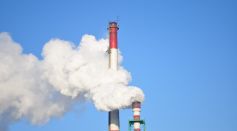Tags: Carbon dioxide
James Webb Space Telescope Discovers Methane and Carbon Dioxide in K2-18 b; Can It Be a Habitable Planet That Support Life?

Gaseous Carbon Dioxide Emerges as Surprising Instigator for Volcanic Eruptions, Offering Clear Picture of Earth's Internal Dynamics

Removing Carbon Dioxide From the Atmosphere Could Not Reverse Climate Change Damages, Study Suggests
Microsoft Signs a Deal With Danish Energy Company Ørsted To Capture Carbon Dioxide Emission

Pioneer Technology To Filter Out Carbon Dioxide From the Ocean: Could This Be the Solution to Climate Change?

How Does Dust Help Ecosystem? Scientists Unravel Its Role in Sustaining Oceans, Controlling Atmospheric Carbon Dioxide Levels

Carbon Capture Technology Using Enzyme Provides Sustainable Solution To Fight Climate Change

How Much Carbon Dioxide Does Each Country Produce? NASA Earth-observing Satellite Measures Emissions of Every Nation

Brown Algae Takes in Carbon Dioxide and Expels It in the Form of "Fucoidan" Mucus; Could This Be the Answer to the Climate Change Crisis?

How Much is Santa's Carbon Footprint on His Journey Around the World? Here's What Scientists Say

Scientists Uncover the Ugly Truth Behind the Surge in Methane

Carbon Dioxide to Reduce Pollution Possible? Here’s What Scientists Say

More and More Lakes Emerging Across the Planet: What Could This Mean to the Environment?

Ocean May Absorb Excess Carbon Dioxide Through Nanoparticles [Study]

James Webb Space Telescope Captures the Most Detailed View of an Exoplanet Atmosphere For the First Time [Look]

Scientists Warn That Earth's Vital Signs Have Reached "Code Red" as They Are Now at Record Extremes

Worsening Climate Change Increases Lifespan of Space Junk Orbiting Earth, Preventing Efforts of Cleaning the Atmosphere

Mars May Have Been Much More Habitable 4 Billion Years Ago Than Today, New Study Suggests

Carbon Capture and Storage in Norway Takes Place as Government Funded 80% of the Structure
Exoplanet 700-Light Years Away Contains Carbon Dioxide Found By James Webb Space Telescope
Most Popular

Largest Known Volcanic Aquifer Discovered Beneath Oregon's Cascades

New 'Supergiant' Sea Bug Found in South China Sea, Named After Darth Vader

Mediterranean Sea Was Refilled by a Catastrophic Flood Millions of Years Ago

Mysterious Cosmic Waves That Sound Like Birds Detected in Unexpected Space Region





